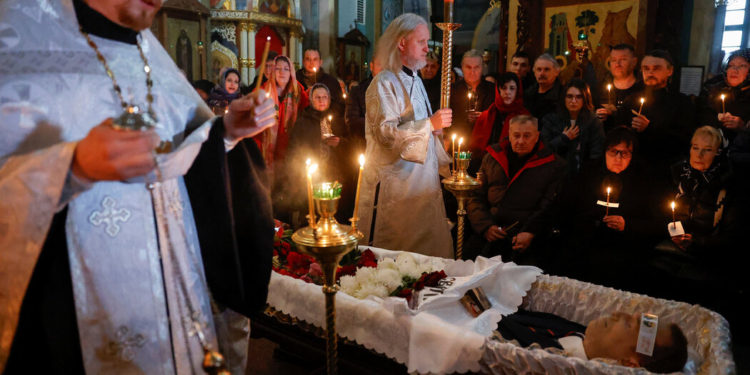By THE NEW YORK TIMES
This image of Aleksei A. Navalny’s body in a coffin, at a church in southern Moscow, conveys many of the traditions of the Russian Orthodox Church, an institution that has bound itself closely to the Kremlin but that also counted opposition figures, including Mr. Navalny, among its faithful.
“I, to my shame, am a typical post-Soviet believer,” Mr. Navalny said in an interview in 2012. “I keep fasts, I got baptized at church, but I go to church quite rarely.”
Being an Orthodox Christian, he said, made him feel “like I am part of something big and shared.”
He added: “I like that there are special ethics and self-restraints. At the same time, it doesn’t bother me at all that I exist in a predominantly atheistic environment. Until I was 25 years old, before the birth of my first child, I myself was such an ardent atheist that I was ready to grab the beard of any priest.”
Those remarks reflected the circumstances of many Russians who came of age as the Soviet Union broke apart and as the Russian Orthodox Church again rose to prominence in public life.
Over the last two decades, the church has tied itself closely to the increasingly conservative and nationalist views espoused by President Vladimir V. Putin. That has forced critics like Mr. Navalny, and pockets of progressive believers, to try to reconcile their political dissent and their faith.
Mr. Navalny’s funeral on Friday took place at the Church of the Icon of the Mother of God Soothe My Sorrows. A funereal chaplet, typically a paper or fabric ribbon with the image of Jesus Christ, the Mother of God and John the Baptist, was lain on his head.
This church in southern Moscow where the Mass was held is not far from where Mr. Navalny lived until 2017 and where his family had an apartment.
In the image, Mr. Navalny’s father, Anatoly, sits facing the coffin. To the right of him is Mr. Navalny’s mother, Lyudmila Navalnaya, and a woman who some Russian media reports identified as his mother-in-law, a relative who has stayed away from the public eye.
Mr. Navalny’s widow, Yulia Navalnaya, and his children did not appear to be present. Ms. Navalnaya has vowed to carry on her husband’s political activities, which exposes her to arrest, and she and their children no longer live in Russia. His brother Oleg, who served time in prison in what was widely seen as a punishment for Mr. Navalny’s political activities, was also absent.
The Russian Orthodox Church has formally embraced Mr. Putin’s invasion of Ukraine, which Mr. Navalny vehemently denounced. Patriarch Kirill, the church’s top official, has blessed soldiers being sent off to war and said that those who fight for their country will be rewarded in heaven.
However, the Orthodox church is relatively decentralized, so even as Mr. Putin cracked down on opposition and dissent, progressive priests remain at some parishes. Priests who have voiced opposition to the war have faced recriminations, in some cases expulsion, from church authorities, and even arrest.
The church where Mr. Navalny’s funeral rites took place has also appeared to endorse the war. Images shared on its social media pages in recent weeks announced that parishioners had donated a car to the soldiers fighting in what the Kremlin calls its “special military operation,” and organized letter writing campaigns for the troops. It also advertised a trip by parishioners and their children to a grand Cathedral of the Russian Armed Forces, which opened in 2020 and has become a symbol of the militarization of Russian society.







Discussion about this post